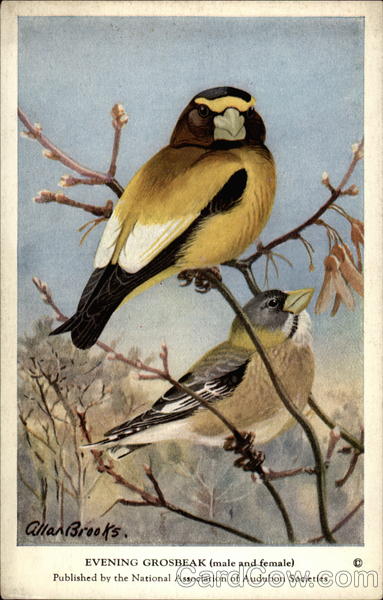Front:
allanBrooks.
EVENING GROSBEAK (male and female)
Published by the National Association of Audubon Societies
Back:
No. 36 Evening Grosbeak
Length 8 inches
An element of mystery has always surrounded
the coming and going of these rare winter visitors
whose boreal home is far beyond the usual haunts
of man. They are very irregular and infrequent
anywhere east of the Mississippi, but now and
then remarkable flights have taken place, bas in
1890 and again in 1910. On such occasions
extreme tameness of the birds is always pery no-
ticeable and is abundant proof of theit innocence
with respect to the ways of civilizations Like its
relative, the Pine Grosbeak, this species wanders
about in flocks of varying size during the winter,
visiting districts of most abundant food supply
It feeds, to a great extenty, upon Buds and the
seeds of trees.
The song is described as a wandering, jerky
warble, beginning low, suddenly increasing in
power, and as suddenly ceásúg as though the
singer were out of breath
The nest, known only from a few examples, is
made of small twigs and rootlets and placed low
in trees or bushes. There are from three to five
eggs, greenish-white, spotted with brown.
Classification: Order Passeres. Family Fringillida.
Scientific Name: Hesperiphona vespertina.
Range: Breeds in the mountains of western British
Columbia and southward to Mexico; winters east of the
Rocky Mountains, south irregularly to Kentucky and
Ohio, and casually east to New England.
No. 36 from set of 50 Winter Birds of the Northeastern United
States. Published by the National Association of Audubon So-
cieties, 1974 Broadway, New York City. Price per set, in a box,
$1.00 post paid.
NOSNIWT



